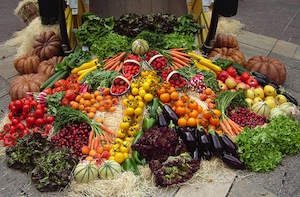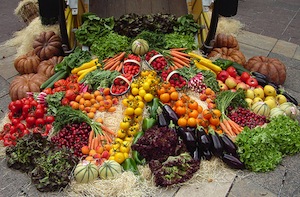 A foodie who has become a believer in sustainable agriculture, Mark Bittman is the author of dozens of cookbooks and Food Matters, an exploration of the links among global warming and other environmental challenges, obesity and the so-called lifestyle diseases, and the overproduction and over consumption of meat, simple carbohydrates, and junk food.
A foodie who has become a believer in sustainable agriculture, Mark Bittman is the author of dozens of cookbooks and Food Matters, an exploration of the links among global warming and other environmental challenges, obesity and the so-called lifestyle diseases, and the overproduction and over consumption of meat, simple carbohydrates, and junk food.
In Sustainable Farming Can Feed the World?, which appeared in the New York Times, Bittman says:
The oldest and most common dig against organic agriculture is that it cannot feed the world’s citizens; this, however, is a supposition, not a fact. And industrial agriculture isn’t working perfectly, either: the global food price index is at a record high, and our agricultural system is wreaking havoc with the health not only of humans but of the earth. There are around a billion undernourished people; we can also thank the current system for the billion who are overweight or obese.
Yet there is good news: increasing numbers of scientists, policy panels and experts (not hippies!) are suggesting that agricultural practices pretty close to organic — perhaps best called “sustainable” — can feed more poor people sooner, begin to repair the damage caused by industrial production and, in the long term, become the norm.
Right on the heals of Bittman’s New York Times article, Tom Philpott (Grist) goes further to debunk the stubborn myth that only industrial ag can “feed the world.” He says that conventional wisdom – that only Big Ag can feed the world – is wrong, or at least much or contested than its champions let on.
Just last week, the UN Environment Program released “Agriculture: Investing in Natural Capital” – the latest in many years of reports contradicting “conventional wisdom.”
Green agriculture, characterized by low-tech, highly-skilled methods like restoring and enhancing soil fertility through the increased use of naturally and sustainably produced nutrient inputs; diversified crop rotations; and livestock and crop integration, can indeed feed the world.
The report concludes:
The use of green agricultural practices and technologies can boost global per capita calorie availability from today’s 2,800 to around 3,500 calories by 2050. And it can do so in a way that doesn’t drive millions of smallholder farmers off the land and into cities ill-equipped to absorb them.
It does appear that there is consensus developing around a new “green revolution” that takes us back to sustainable agricultural practices.
When GoodFood World asked David Lively, one of the original founders and now marketing director of Organically Grown Company (OGC), what the organic movement will look like in 25 years, he said:
I think a lot will change over the next 25 years. In my book, conventional agriculture is based on a lot of non-sustainable limited-resource practices and principles and the chickens are coming home to roost on those.
The conventional system is reaching the end of the road with current practices on a global scale. I expect that there will continue to be more evidence that organic production is a superior system and a lot more sustainable. In an environment of global climate change, it makes a lot more sense to farm organically.
I won’t go out on a limb to say that fresh produce will be 100% organic in 25 years, but in the long run, I believe that organic will become the production method.

